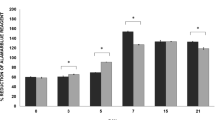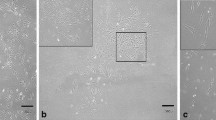Abstract
Human dental pulp of exfoliated deciduous teeth contains the population of cells that exhibited mesenchymal stem cell (MSC) characters. Though, a cell amplification process is indeed required to secure an adequate cell number for such a potential employment. Several publications suggested the alteration of MSCs upon in vitro culture, for example, the decrease in proliferation and the loss of stem cell characters. Here, we investigated an influence of basic fibroblast growth factor (bFGF) on stem cells isolated from human exfoliated deciduous teeth (SHEDs) with respect to cell proliferation, colony forming unit efficiency and stem cell marker expression in both short- and long-term cultures. For short-term bFGF treatment, SHEDs were treated with bFGF for 48 h. While, in long-term bFGF supplementation, SHEDs were maintained in culture and continuous passage upon confluence in medium supplemented with bFGF. Cells at passage (P) 5 and 10 were employed for characterization. Our results showed that short-term bFGF treatment enhanced OCT4, REX1, and NANOG mRNA expression as well as colony forming unit ability. The FGFR inhibitor pretreatment was able to attenuate the influence of bFGF on pluripotent stem cell marker expression, confirming bFGF function. In addition, cells cultured in high passage number had decreased in cell proliferation, colony forming unit capacity, and pluripotent stem cell maker mRNA expression. However, bFGF supplementation in culture medium enhanced both pluripotent stem cell marker expression and colony forming unit capacity in later passage, though the effect was not robust. Together, these results indicate that high passage number may attenuate pluripotent properties of SHEDs and bFGF supplementation could be the beneficial approach to maintain SHEDs’ stemness properties.



Similar content being viewed by others
References
Miura M, Gronthos S, Zhao M, Lu B, Fisher LW, Robey PG, Shi S. SHED: stem cells from human exfoliated deciduous teeth. Proc Natl Acad Sci USA. 2003;100:5807–12.
Nakamura S, Yamada Y, Katagiri W, Sugito T, Ito K, Ueda M. Stem cell proliferation pathways comparison between human exfoliated deciduous teeth and dental pulp stem cells by gene expression profile from promising dental pulp. J Endod. 2009;35:1536–42.
Govindasamy V, Abdullah AN, Ronald VS, Musa S, Ab Aziz ZA, Zain RB, Totey S, Bhonde RR, Abu Kasim NH. Inherent differential propensity of dental pulp stem cells derived from human deciduous and permanent teeth. J Endod. 2010;36:1504–15.
Govitvattana N, Osathanon T, Taebunpakul S, Pavasant P. IL-6 regulated stress-induced Rex-1 expression in stem cells from human exfoliated deciduous teeth. Oral Dis. 2012; doi:10.1111/odi.12052.
Yamaza T, Kentaro A, Chen C, Liu Y, Shi Y, Gronthos S, Wang S, Shi S. Immunomodulatory properties of stem cells from human exfoliated deciduous teeth. Stem Cell Res Ther. 2010;1:5.
Nourbakhsh N, Soleimani M, Taghipour Z, Karbalaie K, Mousavi SB, Talebi A, Nadali F, Tanhaei S, Kiyani GA, Nematollahi M, Rabiei F, Mardani M, Bahramiyan H, Torabinejad M, Nasr-Esfahani MH, Baharvand H. Induced in vitro differentiation of neural-like cells from human exfoliated deciduous teeth-derived stem cells. Int J Dev Biol. 2011;55:189–95.
Sakai VT, Zhang Z, Dong Z, Neiva KG, Machado MA, Shi S, Santos CF, Nor JE. SHED differentiate into functional odontoblasts and endothelium. J Dent Res. 2010;89:791–6.
Ishkitiev N, Yaegaki K, Calenic B, Nakahara T, Ishikawa H, Mitiev V, Haapasaio M. Deciduous and permanent dental pulp mesenchymal cells acquire hepatic morphologic and functional features in vitro. J Endod. 2010;36:469–74.
Nishino Y, Ebisawa K, Yamada Y, Okabe K, Kamei Y, Ueda M. Human deciduous teeth dental pulp cells with basic fibroblast growth factor enhance wound healing of skin defect. J Craniofac Surg. 2011;22:438–42.
Seo BM, Sonoyama W, Yamaza T, Coppe C, Kikuiri T, Akiyama K, Lee JS, Shi S. SHED repair critical-size calvarial defects in mice. Oral Dis. 2008;14:428–34.
Cordeiro MM, Dong Z, Kaneko T, Zhang Z, Miyazawa M, Shi S, Smith AJ, Nor JE. Dental pulp tissue engineering with stem cells from exfoliated deciduous teeth. J Endod. 2008;34:962–9.
Wang X, Sha XJ, Li GH, Yang FS, Ji K, Wen LY, Liu SY, Chen L, Ding Y, Xuan K. Comparative characterization of stem cells from human exfoliated deciduous teeth and dental pulp stem cells. Arch Oral Biol. 2012;57:1231–40.
Kim J, Kang JW, Park JH, Choi Y, Choi KS, Park KD, Baek DH, Seong SK, Min HK, Kim HS. Biological characterization of long-term cultured human mesenchymal stem cells. Arch Pharm Res. 2009;32:117–26.
Liu L, Wei X, Huang R, Ling J, Wu L, Xiao Y. Effect of bone morphogenetic protein-4 (BMP-4) on the expression of Sox2, Oct-4 and c-Myc in human periodontal ligament cells during long-term culture. Stem Cells Dev. 2013;. doi:10.1089/scd.2012.0548.
Murakami S. Periodontal tissue regeneration by signaling molecule(s): what role does basic fibroblast growth factor (FGF-2) have in periodontal therapy? Periodontol 2000. 2011;56:188–208.
She Z, Wang C, Li J, Sukhorukov GB, Antipina MN. Encapsulation of basic fibroblast growth factor by polyelectrolyte multilayer microcapsules and its controlled release for enhancing cell proliferation. Biomacromolecules. 2012;13:2174–80.
Osathanon T, Nowwarote N, Pavasant P. Basic fibroblast growth factor inhibits mineralization but induces neuronal differentiation by human dental pulp stem cells through a FGFR and PLCgamma signaling pathway. J Cell Biochem. 2011;112:1807–16.
Narong S, Leelawat K. Basic fibroblast growth factor induces cholangiocarcinoma cell migration via activation of the MEK1/2 pathway. Oncol Lett. 2011;2:821–5.
Ezeonu I, Derrickson B, Dutt K. Cell fate decisions in a human retinal precursor cell line: basic fibroblast growth factor- and transforming growth factor-alpha-mediated differentiation. DNA Cell Biol. 2000;19:527–37.
Levenstein ME, Ludwig TE, Xu RH, Llanas RA, VanDenHeuvel-Kramer K, Manning D, Thomson JA. Basic fibroblast growth factor support of human embryonic stem cell self-renewal. Stem Cells. 2006;24:568–74.
Li Y, Tsai YT, Hsu CW, Erol D, Yang J, Wu WH, Davis RJ, Egli D, Tsang SH. Long-term safety and efficacy of human-induced pluripotent stem cell (iPS) Grafts in a preclinical model of retinitis pigmentosa. Mol Med. 2012;18:1312–9.
Colleoni S, Bottani E, Tessaro I, Mari G, Merlo B, Romagnoli N, Spadari A, Galli C, Lazzari G. Isolation, growth and differentiation of equine mesenchymal stem cells: effect of donor, source, amount of tissue and supplementation with basic fibroblast growth factor. Vet Res Commun. 2009;33:811–21.
Suchanek J, Soukup T, Ivancakova R, Karbanova J, Hubkova V, Pytlik R, Kucerova L. Human dental pulp stem cells–isolation and long term cultivation. Acta Medica (Hradec Kralove). 2007;50:195–201.
Kalmar T, Lim C, Hayward P, Muñoz-Descalzo S, Nichols J, Garcia-Ojalvo J, Martinez Arias A. Regulated fluctuations in nanog expression mediate cell fate decisions in embryonic stem cells. PLoS Biol. 2009;7(7):e1000149.
Chieregato K, Castegnaro S, Madeo D, Astori G, Pegoraro M, Rodeghiero F. Epidermal growth factor, basic fibroblast growth factor and platelet-derived growth factor-bb can substitute for fetal bovine serum and compete with human platelet-rich plasma in the ex vivo expansion of mesenchymal stromal cells derived from adipose tissue. Cytotherapy. 2011;13:933–43.
Yamachika E, Tsujigiwa H, Matsubara M, Hirata Y, Kita K, Takabatake K, Mizukawa N, Kaneda Y, Nagatsuka H, Iida S. Basic fibroblast growth factor supports expansion of mouse compact bone-derived mesenchymal stem cells (MSCs) and regeneration of bone from MSC in vivo. J Mol Histol. 2012;43:223–33.
Lee JH, Um S, Jang JH, Seo BM. Effects of VEGF and FGF-2 on proliferation and differentiation of human periodontal ligament stem cells. Cell Tissue Res. 2012;348:475–84.
Wu J, Huang GT, He W, Wang P, Tong Z, Jia Q, Dong L, Niu Z, Ni L. Basic fibroblast growth factor enhances stemness of human stem cells from the apical papilla. J Endod. 2012;38:614–22.
Li Z, Liu C, Xie Z, Song P, Zhao RC, Guo L, Liu Z, Wu Y. Epigeneitc dysregulation in mesenchymal stem cell aging and spontaneous differentiation. PLoS One. 2011;6:e20526.
Li B, Qu C, Chen C, Liu Y, Akiyama K, Yang R, Chen F, Zhao Y, Shi S. Basic fibroblast growth factor inhibits osteogenic differentiation of stem cells from human exfoliated deciduous teeth through ERK signaling. Oral Dis. 2012;18:285–92.
Nakamizo S, Egawa G, Doi H, Natsuaki Y, Miyachi Y, Kabashima K. Topical treatment with basic fibroblast growth factor promotes wound healing and barrier recovery induced by skin abrasion. Skin Pharmacol Physiol. 2013;26:22–9.
Wissink M, Beernink R, Scharenborg N, Poot A, Engbers G, Beugeling T, van Aken W, Feijen J. Endothelial cell seeding of (heparinized) collagen matrices: effects of bFGF pre-loading on proliferation (after low density seeding) and pro-coagulant factors. J Control Release. 2000;67:141–55.
Acknowledgments
This study was partially supported by Research Funding, Graduate School, Chulalongkorn University, “Integrated Innovation Academic Center: IIAC” Chulalongkorn University Centernary Academic Development Project (CU56-HR07) and the Higher Education Research Promotion and National Research University Project of Thailand, Office of the Higher Education Commission (HR1166I). WS and TO were supported by DRU in Stem Cell Research Fund and Faculty of Dentistry Research Funding, Chulalongkorn University. PP was supported by the Research Chair Grant 2012, the National Science and Technology Development Agency (NSTDA), Thailand
Conflict of interest
The authors declare that they have no conflict of interest.
Author information
Authors and Affiliations
Corresponding author
Rights and permissions
About this article
Cite this article
Sukarawan, W., Nowwarote, N., Kerdpon, P. et al. Effect of basic fibroblast growth factor on pluripotent marker expression and colony forming unit capacity of stem cells isolated from human exfoliated deciduous teeth. Odontology 102, 160–166 (2014). https://doi.org/10.1007/s10266-013-0124-3
Received:
Accepted:
Published:
Issue Date:
DOI: https://doi.org/10.1007/s10266-013-0124-3




